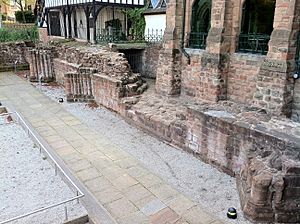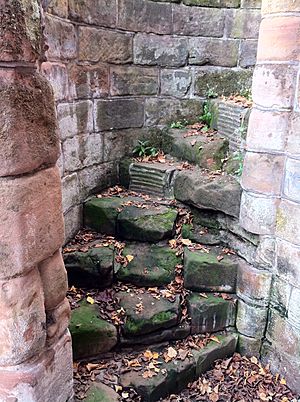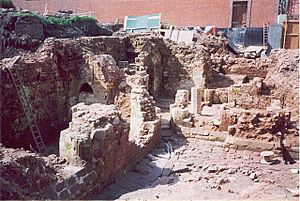St Mary's Priory and Cathedral facts for kids
St Mary's Priory and Cathedral was an important Roman Catholic building in Coventry, England. It started as a monastery in the 12th century and later became both a priory (a type of monastery led by a prior) and a cathedral. Sadly, it was destroyed in the early 1500s during a time called the Dissolution of the Monasteries. Today, you can visit the ruins of its west end in the center of Coventry. It's located near Holy Trinity Church and the old St Michael's Church.
Contents
How St Mary's Cathedral Began
The story of Coventry begins around 1016. At that time, King Canute and his Danish army were attacking many towns in England. When they reached Coventry, they destroyed a Saxon nunnery (a place where nuns lived).
Later, in 1043, a powerful leader named Leofric, Earl of Mercia and his wife, Lady Godiva, decided to rebuild on the nunnery's ruins. They founded a Benedictine monastery dedicated to St Mary. It was built for an abbot (the head of a monastery) and 24 monks. People at the time said it was incredibly rich with gold, silver, jewels, and precious stones.
Around 1095, a bishop named Robert de Limesey moved his main church (his see) to Coventry. In 1102, the Pope agreed to this move. This decision also changed the monastery of St Mary into both a priory and a cathedral. It took about 125 more years to finish rebuilding and expanding the church.
When the monastery was first built, Earl Leofric gave the monks half of his land in Coventry to support them. This part was known as the "Prior's-half." The other half was called the "Earl's-half." This is why Coventry was divided into two parts for a long time. In 1250, the Earl at the time sold his rights to the Prior. For the next 95 years, the Prior controlled most of the town. However, there were still disagreements between the monks' tenants and the Earl's former tenants. The Prior never fully controlled Coventry.
What the Cathedral Looked Like
The main cathedral building was shaped like a cross. It was about 425 feet (130 meters) long and 145 feet (44 meters) wide at the front. It was built in two main stages, finishing around 1250. The cathedral had a tall tower in the middle and two towers at the west end. You can still see parts of these towers today. Many believe it had three spires, similar to, but older than, those at Lichfield Cathedral.
A Brief History of St Mary's
The abbey church of St Mary's was officially opened in 1043. Earl Leofric, who helped build it, was buried there in 1057.
In 1143, a man named Robert Marmion tried to take control of Coventry Castle. He fortified (strengthened) the cathedral, which was still being built, and even dug a trench around it.
In 1459, an important meeting called the "Parliament of Devils" took place in the priory's chapter house. This happened during the Wars of the Roses, a series of wars for the English throne.
During the 1500s, King Henry VIII decided to close down many monasteries and religious buildings in England. This period is known as the Dissolution of the Monasteries. The king offered the cathedral buildings to the people of Coventry. However, they couldn't gather enough money to buy them. So, the king ordered the buildings to be destroyed. Stones and other materials were taken and used for other buildings. This left only parts of the cathedral standing. St Mary's was the only English cathedral to be completely destroyed during this time. In 1539, the main church for the area was moved to Lichfield Cathedral. It was then called the Diocese of Lichfield and Coventry.
One part, the north-west tower, survived the destruction. It was used as a house until 1714. Then, a charity school called Coventry's Blue Coat School was started there.
Coventry didn't have its own cathedral again until 1918. At that time, St Michael's parish church, which was built in the 1300s and 1400s, became the new cathedral. Sadly, St Michael's was badly damaged during the Coventry Blitz (air raids by Germany) on November 14, 1940. After the war, a new St Michael's Cathedral was built next to the ruins of the old one.
Finding and Digging Up the Past
In 1856, the Blue Coat School was rebuilt on the same spot. During this construction, workers found the remains of the cathedral's west wall. This included the bottom of the south-west tower and its spiral staircase. The school building is still there, but the school itself moved in the 1960s.
Another excavation in the 1960s uncovered the original doorway to the chapter house (a meeting room for the monks).
In the late 1990s, the Coventry City Council decided to turn part of the cathedral site into a public park. They invited the TV show Time Team to do an archaeological dig there.
The dig happened in April 1999. The archaeologists dug four main trenches (long, narrow ditches). One was in the area of the chapter house. Another went down four meters to reach the original floor level. The other two helped find where the two crossing piers (supports for the tower and roof) would have been.
The archaeologists looking in the chapter house couldn't find the doorway that had been photographed in the 1960s. It wasn't until the third day of their three-day dig that they realized the earlier team must have taken it. This delay meant they only found a stone-lined grave at the bottom of a trench on the very last day. Some of the team stayed an extra day to explore this discovery.
On the fourth day, they found the remains of a body in the grave, just inside the chapter house door. Experts suggested the person died in late middle age and was overweight and diabetic. They believed it was likely a prior (the head of the priory).
Time Team came back to the site in March 2001 for another show. They explored new discoveries made since their first visit. Coventry Archaeology had continued digging at the priory, and Northampton Archaeology worked on the cathedral. One cool find was a layer of clay near the entrance. It still had marks from the wheels of carts. These carts were probably used to remove stones after the building was torn down.
Another exciting discovery in December 2000 was the 14th-century 'Apocalypse Mural'. While clearing debris from an undercroft (an underground room), a small piece of stone with a painted gold crown was found. A few days later, a larger piece of sandstone was found. It measured about 43 cm by 50 cm and had a painted area showing four heads, three of them wearing crowns.
Today, you can see the remains from both ends of the cathedral building. They show that it was once about 425 feet (130 meters) long.
After the excavations, parts of the ruins are now open to the public as the 'Priory Garden'. You can walk through or above them on wooden walkways. The area where the cloisters (covered walkways) used to be is also a park with a visitor center. This center displays some of the items found during the digs.
People Buried Here
- Leofric, Earl of Mercia
- Lady Godiva
- Ælfgar, Earl of Mercia
- John Hastings, 1st Baron Hastings and his wife Isabel de Valence
- Richard Gernon of Wybunbury, 2nd son of Ranulf Gernon, 4th Earl of Chester
See also
 In Spanish: Priorato y Catedral de Santa María para niños
In Spanish: Priorato y Catedral de Santa María para niños




